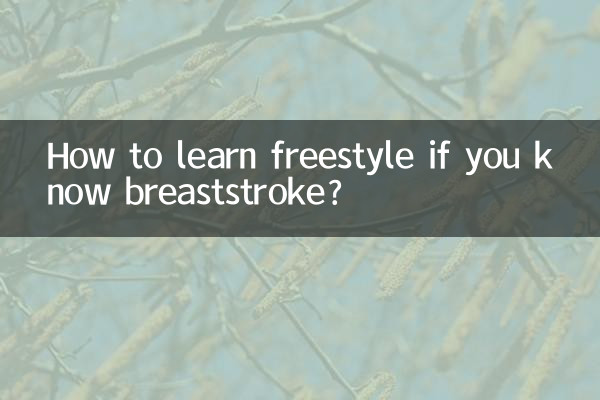How to learn freestyle if you know breaststroke?
If you've already mastered breaststroke, it's relatively easy to learn freestyle. Freestyle is the fastest stroke in swimming and one of the most common strokes in competition. This article will provide you with a detailed freestyle learning guide to help you transition from breaststroke to freestyle.
1. The main differences between freestyle and breaststroke

Freestyle and breaststroke are technically very different, here are the main differences between the two:
| Comparative item | Breaststroke | freestyle |
|---|---|---|
| arm movements | Stroke with both arms at the same time, pushing outward | Stroke the water alternately with both arms, forming an S shape |
| Leg movements | Push the water with both legs at the same time, in a frog position | Use your legs alternately to pump water and kick up and down |
| breathing pattern | Lift your head and breathe | sideways breathing |
| body posture | The body fluctuates greatly | Keep your body level and streamlined |
2. Learning steps for freestyle swimming
1.Master freestyle kicking techniques
The freestyle kick is an alternating up and down kick, which is completely different from the breaststroke kick. You can use a kickboard when practicing and focus on the movements of your legs. When kicking, bend your knees slightly, relax your ankles, and use your thighs to drive your calves to kick.
2.Learn arm strokes
The arm movement of freestyle is alternating strokes, forming an S shape. When paddling, your arms enter the water from the front, push the water back, and finally exit the water from the side of your thighs. During practice, you can practice single-arm paddling alone and gradually transition to alternating arms.
3.Practice sideways breathing
Freestyle breathing is sideways breathing, which is different from breaststroke head-up breathing. When breathing, turn your head sideways with the stroke of your arms, and quickly turn back to the water after inhaling. It is recommended to practice breathing movements in shallow water first, and then combine them with paddling after you become proficient.
4.Coordinate whole body movements
Combine your kick, stroke, and breathing to create a smooth freestyle motion. You can slow down at the beginning and gradually improve your coordination.
3. Common problems and solutions
| question | Reason | Solution |
|---|---|---|
| body sinking | Kicks are not strong enough or head is raised too high when breathing | Strengthen your kicking exercises, keep your body level, and turn your head to the side instead of raising your head when breathing. |
| Inefficient arm stroke | Incorrect strokes or insufficient arm strength | Correct paddling movements, practice single-arm paddling, and enhance arm strength |
| difficulty breathing | Wrong timing of breathing or excessive head rotation | Practice breathing rhythm and reduce head rotation |
4. Practice plan
Here's a two-week freestyle practice plan to help you master freestyle step by step:
| time | Exercise content | target |
|---|---|---|
| Day 1-3 | Kick exercises (using a kickboard) | Master the basic movements of freestyle kick |
| Day 4-6 | One-arm paddling exercise | Familiar with arm strokes |
| Days 7-9 | Breathing exercises (side head breathing) | Master the rhythm of breathing |
| Day 10-14 | whole body coordination exercises | Complete the complete freestyle routine |
5. Summary
Transitioning from breaststroke to freestyle takes time and patience, but as long as you follow the correct steps and gradually master the techniques of kicking, paddling, and breathing, you will be able to learn freestyle. Remember, swimming is a sport that requires repeated practice, don’t rush and enjoy the learning process!

check the details

check the details